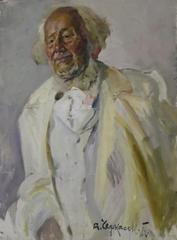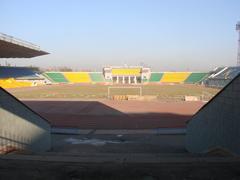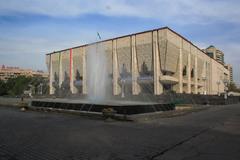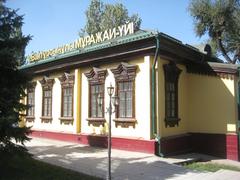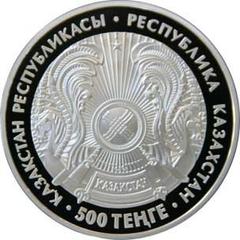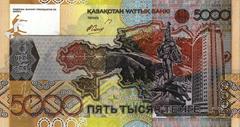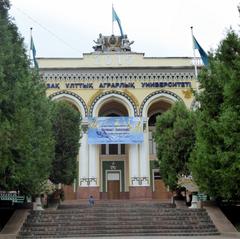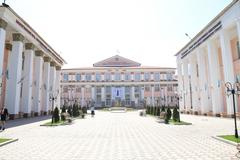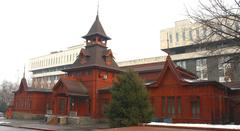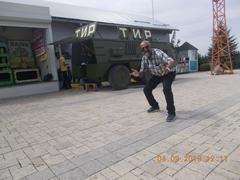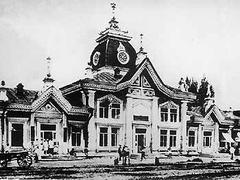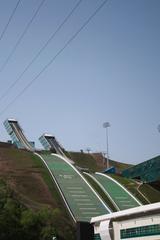
House of Merchant M.A. Gavrilov, Almaty: Visiting Hours, Tickets, and Historical Significance
Date: 04/07/2025
Introduction
The House of Merchant M.A. Gavrilov is among Almaty’s most captivating historical landmarks, offering a window into the city’s vibrant mercantile heritage and architectural ingenuity. Built at the turn of the 20th century, this wooden masterpiece reflects the economic ascent and cosmopolitan transformation of Almaty—once called Verny—during a period of intense urban development. Today, the Gavrilov House stands as a symbol of Almaty’s merchant class and as a testament to the city’s fusion of Russian and Central Asian architectural traditions. This guide delivers essential background, practical visitor information, and insights into its enduring cultural value.
Historical Context: From Verny to Almaty
Russian Expansion and Urban Development
Following the Russian Empire’s annexation of the Kazakh steppe, Verny (now Almaty) evolved rapidly from a military outpost into a bustling urban center. Russian settlers, administrators, and merchants spurred this transformation, bringing new economic opportunities and cultural influences (e-history.kz).
The Rise of the Merchant Class
Merchants like M.A. Gavrilov capitalized on Almaty’s strategic location along major trade routes connecting Central Asia, Russia, and China. The merchant class played a pivotal role in shaping the city’s infrastructure, culture, and civic life, contributing not only to commerce but also to the development of educational and cultural institutions (e-history.kz).
Economic Integration and Urban Society
By the late 19th century, Verny had become a key trading hub, with merchants facilitating commerce with neighboring regions. Their influence extended beyond economics, shaping the city’s social fabric and supporting philanthropic and cultural projects (world-nan.kz).
Architectural and Cultural Significance
Distinctive Design and Construction
The Gavrilov House exemplifies the blending of Russian provincial styles with local Kazakh craftsmanship. Its ornate wooden facades, intricate latticework, and earthquake-resistant construction techniques are not only visually striking but also practical—a necessity in Almaty’s seismically active environment (Wikipedia: Architecture of Almaty).
- Wooden Construction: Advanced joinery and cross-bracing, a response to frequent earthquakes, provide both flexibility and resilience.
- Decorative Facade: The house features lacy cornices, carved columns, a scaly dome, and traditional Kazakh latticework, symbolizing both wealth and cross-cultural artistry (e-a-a.com).
- Interior Layout: Spacious halls and high ceilings reflect the lifestyle of Almaty’s bourgeoisie, designed for both family life and business dealings.
Symbol of Urban Prosperity
The Gavrilov House stands as a monument to Almaty’s pre-revolutionary prosperity. Alongside other merchant buildings, it defined the urban landscape and contributed to Almaty’s reputation as a “garden city” with its tree-lined streets and green courtyards (Wikipedia: Architecture of Almaty).
Cultural Importance
Merchant families like the Gavrilovs were instrumental in shaping Almaty’s multicultural identity. Their homes served as centers of business, community, and hospitality, reflecting both Kazakh and Russian traditions (Commisceo Global).
Visiting Information
Hours and Admission
- Opening Hours: Tuesday to Sunday, 10:00 AM – 6:00 PM; closed Mondays.
- Tickets: 500 KZT for adults; discounts available for students, seniors, and groups.
- Guided Tours: Daily at 11:00 AM and 3:00 PM. Advance booking is recommended for guided tours, which are available in several languages (Visit Almaty).
Location and Getting There
- Address: Jibek Joly Street, central Almaty.
- Access: A short walk from the Zhibek Zholy metro station; accessible by bus, tram, taxi, or ride-hailing services (things.in).
- Parking: Limited; public transportation is recommended.
Accessibility
The house offers wheelchair access and staff assistance for visitors with limited mobility. Due to its historic structure, some areas may have restricted access—contact the site in advance for details.
Photography and Guidelines
Photography is generally permitted, but flash and tripods are not allowed indoors to protect delicate interiors. Please respect posted guidelines and staff instructions.
Visitor Experience
- Self-Guided Visits: Informational plaques in Kazakh, Russian, and English provide context for independent exploration.
- Special Events: The house regularly hosts cultural events, exhibitions, and educational workshops—check the official website for schedules.
- Nearby Attractions: Combine your visit with trips to the Green Bazaar, Zenkov Cathedral, Central State Museum, and Arbat pedestrian street for a full day of cultural sightseeing.
Preservation and Community Engagement
Conservation Efforts
Maintaining the Gavrilov House is an ongoing challenge due to urban development, climatic conditions, and the natural vulnerabilities of wooden structures. Restoration projects focus on preserving original features, retrofitting for earthquake safety, and updating facilities (Funds for NGOs).
Community and Educational Initiatives
The house serves as a hub for heritage education and community engagement, with programs designed to foster civic pride and intercultural understanding, particularly among younger generations (Funds for NGOs).
Practical Tips for Visitors
- Best Seasons: Spring (April–June) and autumn (September–November) for mild weather and vibrant city life.
- Travel Preparation: Wear comfortable shoes, bring layers for changing temperatures, and carry bottled water (oneintheorangejacket.com).
- Connectivity: Local SIM cards and eSIMs from Beeline, Kcell, or Tele2 are easy to acquire (things.in).
- Safety: Almaty is generally safe, but standard precautions are advised. Have your embassy’s contact information and travel insurance details handy.
Frequently Asked Questions (FAQ)
Q: What are the House of Merchant M.A. Gavrilov’s opening hours?
A: Tuesday to Sunday, 10:00 AM to 6:00 PM; closed on Mondays.
Q: How much are tickets?
A: 500 KZT for adults, with student and senior discounts.
Q: Are guided tours available?
A: Yes, daily at 11:00 AM and 3:00 PM; advance booking is recommended.
Q: Is the house wheelchair accessible?
A: Yes, with some limitations due to the building’s historical structure.
Q: Can I take photographs?
A: Yes, but flash and tripods are not permitted indoors.
Q: What are nearby attractions?
A: Green Bazaar, Zenkov Cathedral, Central State Museum, and Arbat pedestrian street.
Conclusion and Recommendations
The House of Merchant M.A. Gavrilov is more than a preserved building—it is a living monument to Almaty’s historical evolution, architectural creativity, and the enduring legacy of its merchant class. Its intricate wooden design, cultural symbolism, and role in urban society make it a must-visit for anyone interested in Kazakhstan’s past and present. Enhance your visit by joining a guided tour, attending cultural events, and exploring surrounding landmarks. For the latest details, consult the Visit Almaty website, and consider using the Audiala app for audio guides and updates. Immerse yourself in the story of Almaty, starting with the Gavrilov House.
Sources
- e-history.kz
- Wikipedia: Architecture of Almaty
- CGTN
- Visit Almaty
- e-a-a.com
- orangesmile.com
- Funds for NGOs
- Commisceo Global
- things.in
- oneintheorangejacket.com
- TourHQ
- Kazakhstan Guided Tours
- world-nan.kz
- pg.world

